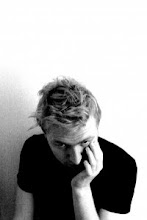A few people lately have been asking me about how I devise theatre and make new work without a script. So I thought I'd cast a little light on the matter.
My work is preoocupied with human interactions, I'm intersted in the varying levels in trust we place in each other and the responsibilities we acquire. This is a good starting point as the art of collaboration is in establishing relationships with people so I can draw themes and patterns from the process itself. I like to take one aspect of an interaction and explore and highlight all the possible connoatations.
I use movement motifs to creatively tell stories. I workshop loads of ideas through a variety of techniques including verbatim (be this via email, found text on internet forums, or voice recording people to get there responses to situations), improvisation (in the studio playing with ideas allowing anything to happen) and game play. I like to draw my ideas from a wide range of stimuli - music, pictures, past experiences, films, journals, art. I enjoy finding connections between things.
I like to work intensively on projects and generate too much material that I can then edit rather than just making enough and having to stretch it. It is important to me to create and destroy the illusion of theatre in my work, I draw comparisons in the way people trust each other and the way an audiences trusts a performer to entertain. Both can be manipulative.
Instructions form a large basis of the rehearsal process. We pass each other notes with instructions on that can be interpreted in any and at any time, this ensure a playful and suprising studio practice that is always exciting. I like setting rules and parameters also, creating situations where the normal is not allowed and creating a dynamic and focus rehearsal environment.
At Left at the Theatre I work with Rachel McCarter with whom I trained. We both enjoy testing the limitations of the body, the limitations of physicality and the limitations of time in performance. In rehearsals we often go through routines, and physical tasks set by each other until we physically cannot do it anymore. As the performer tires and exhaustion takes over the bodies mechanisms for coping set in and the shapes and visceral experiences make for interesting theatre-the body has to change when it is exhausted. "Acting" is often abandoned and tasks take over.
Taking performance away from the theatre allows Left at the Theatre to reach a wider audience and create a more fluid style of work. Using the space as part of the stimulus for the performance is important to me, true site specificity where the performance and the place are integral to each other is key to creating successful work. We explore the limits of time in performance. We depend on spaces to frame it. The body communicates the relationship between Space and Time.
Quite often I will just take a visual idea and run with it, testing it, interrogating it for mileage and integrity or symbolic value. I scrap a lot of my work, especially things that I think are the best and definately things that I think are precious. A lot of the time personal experience comes in to the work, I blend together fiction and non-fiction and it becomes a game to the audience who are asked to figure out which sections are taken from life and which are made-up; trust again.
We work on more than one project at a time. Often ideas that occur whilst we are attempting to create one piece will be more suitable for the other, so we have to be fluid and allow crossovers. It is a bit like a lego building, you have to find right pieces to stick to each other to make it look right. This parallel rehearsal structure sometimes means quoting our own work within pieces.
I like to set up an environment where no idea is too small or superfluous or silly, playfulness is imperative even if we are performing a sad or low moment it must be done creatively.
Thursday 12 November 2009
Subscribe to:
Posts (Atom)
